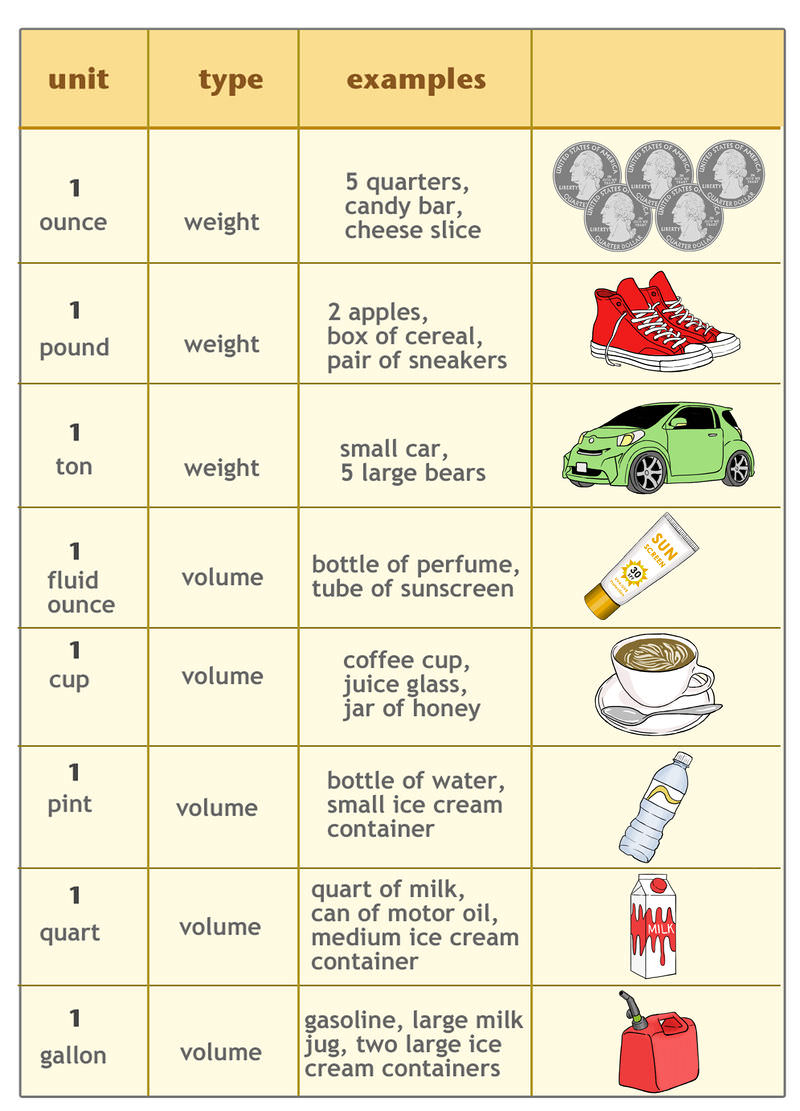3.1.2: Introduction to Customary Units of Mass and Capacity
- Page ID
- 8735
Introduction to Customary Units of Length

Jeffrey works part-time at the butcher shop. Today he is labeling single portions of steak and bottling the store's special barbeque sauce. Each item must be measured accurately in order to be priced correctly. Which unit of measurement should Jeffery use to label the steaks and the bottles of barbecue sauce?
In this concept, you will learn how to choose the best unit of weight or measure.
Selecting the Appropriate Weight or Capacity Units
Choosing the correct units can make all the difference for a measurement. You would not measure how tall you are in miles. Neither would you measure length of a football field in inches. The same idea applies for weight and volume. If you were making a pot of soup, it could be pretty complicated to measure the amount of liquid in ounces. Think of how challenging that would be as you are measuring. To get an idea of the size of the units of weight and volume, take a look at the table below.

This table is useful as a reference for many of the different ways to measure weight and capacity. Think about what you are measuring before you choose a unit. Use units of weight to find how heavy an object is. Use units of volume to find how much space that object takes up. Generally, the size of the object you are measuring can give you a clue as to which unit to use.
Which unit of measurement would you use to weigh a large dog?
There are three units of weight in the table-- ounce, pound, and ton. Think about which unit would work best for this example.
The ounce is too small of a unit. A large dog would weigh several hundred ounces. The ton is too large of a unit. The pound would be the best unit to measure the weight of a large dog.
Examples
Example 3.1.2.1
Earlier, you were given a problem about Jeffrey at the butcher shop.
Jeffrey has to label the steak packages and bottles of barbeque sauce. He has to decide which unit would work best to accurately label each item.
Solution
First, consider the packages of steak. Most of the steaks are less than a pound. Therefore, Jeffrey should use ounces to label the packages of steak.
Then, consider the bottles of barbecue sauce. The bottles are about the size of a water bottle. He has several options he can use— fluid ounce, cup, or pint. The most accurate unit would be the smallest unit. Therefore, Jeffrey should use fluid ounces to label the bottles of barbecue sauce.
Example 3.1.2.2
Choose the best unit of measure: if Darcy is filling up her swimming pool, which unit of capacity would she use to measure the amount of water needed?
Solution
Think about what is being measured. A swimming pool requires a large amount of water. Darcy would use gallons, the largest unit for capacity.
Example 3.1.2.3
Choose the best unit of measure: the milk in a baby bottle.
Solution
Measure the capacity of a baby bottle using fluid ounces.
Example 3.1.2.4
Choose the best unit of measure: a bundle of wood.
Solution
Measure the weight of a bundle of wood using pounds.
Example 3.1.2.5
Choose the best unit of measure: flour for a cake.
Solution
Measure the capacity of flour for a cake using cups.
Review
Choose the best unit of measure for each item below.
- The weight of a dog
- The weight of a camper
- Soda in a can
- Two Elephants
- A television set
- A baby bottle
- A jug of milk
- An automobile
- The water in a pool
- A pile of pennies
- A pallet of wood pellets
- A rhinocerous
- A boat
- An apple
- Water in an eye dropper
Review (Answers)
To see the Review answers, open this PDF file and look for section 7.15.
Vocabulary
| Term | Definition |
|---|---|
| Cup | A cup is a small customary unit for measuring liquid capacity. One cup is equal to eight ounces or about 0.25 liters. |
| Customary System | The customary system is the measurement system commonly used in the United States, including: feet, inches, pounds, cups, gallons, etc. |
| Fluid Ounce | A fluid ounce is a customary unit for measuring liquid capacity. Soft drinks are measured in fluid ounces. |
| Gallon | A gallon is a unit of liquid capacity. One gallon is equivalent to four quarts. |
| Ounces | Ounces are the smallest common unit of weight in the customary system, used to measure very light items. |
| Pint | A pint is a unit of liquid capacity. One pint is equivalent to two cups. |
| Pounds | Pounds are one of the most common units for measuring weight. |
| Quart | A quart is a unit of capacity that is equivalent to two pints. |
| Ton | A ton is the largest common unit for measuring weight. Very large items like cars and trucks are measured in tons. |
| Weight | Weight is a measurement of the heaviness or mass of someone or something. The customary units of weight included ounces, pounds, and tons. |
Additional Resources
PLIX Interactive: Using the Right Units
Practice: Introduction to Customary Units of Mass and Capacity
Video:

